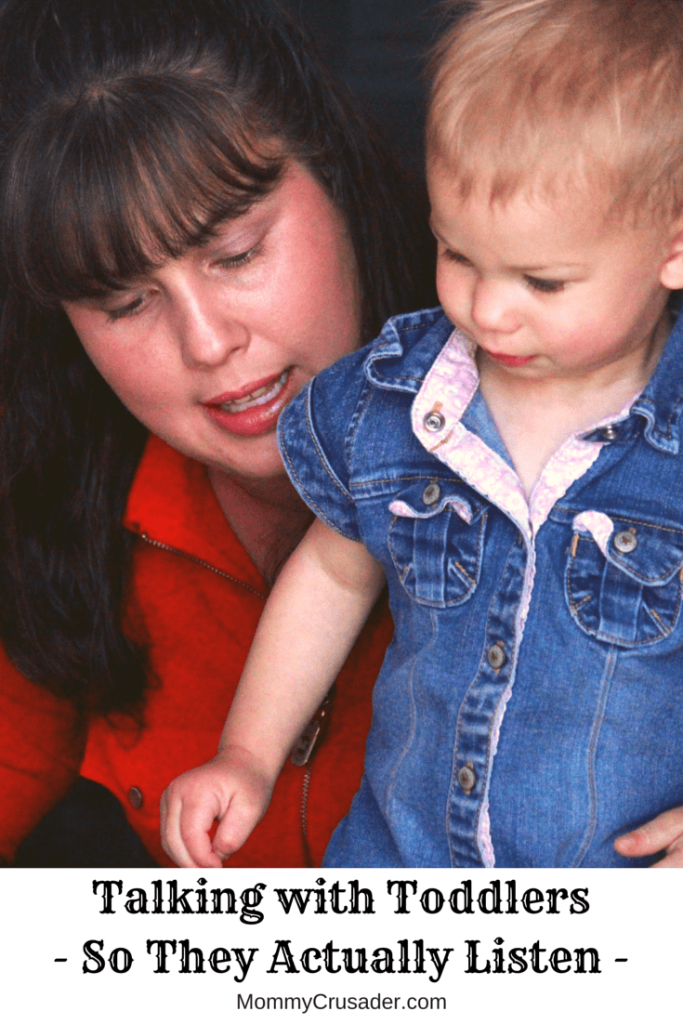Toddlers are so much fun. They see the world from such a different perspective – obviously, when they are no taller than an adult’s knee. Sometimes talking with them feels like an exercise in futility. But there are a few things parents can do when talking with toddlers so they actually listen.
First, it’s important to remember that toddlers’ ability to understand language far exceeds their ability to use language. Also, unless otherwise noted by the child’s pediatrician, most toddlers have good hearing – speaking louder doesn’t usually help them hear any better.
Tip 1: Talk with your toddler, all the time, about everything.
Toddlers depend on their parents to make gains in their language acquisition and usage. They learn by example, and will mimic the language their parents use. Using as much language as possible with toddlers will help them develop their ability to speak clearly much more quickly. This will help them be better able to communicate their needs and desires. Even if you look silly, keep a running commentary going. “What color is the car? Is the car yellow? Do you see the yellow car? Oh, look at the blue car. I’ll bet the blue car can go really fast. . .” your child is intently listening and learning all the words you are using.
Tip 2: Listen to your toddler
If parents want their toddlers to listen to them – they need to listen to their toddlers. Talking and listening go hand in hand. One cannot happen without the other. Toddlers often use their whole bodies to communicate with their parents. Noticing those body language clues and recognizing them verbally with any toddler will let the toddler know they are being listened to and understood. By actively listening to toddlers, parents show them that their needs are as important as the needs of the parents. This respect will be reciprocated when it comes time for the toddler to listen to what the parent is saying.
Tip 3: Get down on the toddler’s level
As cliché as it seems, it really does help to be on the same level as the toddler. Remember, these children are shorter than their adult’s knee on average. Messages delivered from a standing adult are very intimidating. Take a moment to bend down and look the toddler in the eye. This will help get the toddler’s attention and makes sure the message is successfully delivered.
Tip 4: Show more than tell
Toddlers are capable of following very simple directions, but only if they understand what the directions mean. There is a story about a young mother who told her child he could go as far as the corner while he was playing outside. Repeatedly, the mother needed to correct the child for going farther than the corner. With each repeated correction, the mother got more and more frustrated. Finally, with tears streaming, the young child asked, “Mommy, what’s a corner?”
Mommy, what’s a corner?
When speaking with toddlers, showing them what they need to do is often much more effective than assuming they understand what you are asking them to do. Take the time to take the child by the hand and help them perform the task. After doing this a few times, the toddler will then know what is expected and will do it independently.
The young mother in the example above would have had better success if she had taken the time to walk the child down to the corner and explain the boundaries in that manner, rather than just assume the child understood what a corner was.
Tip 5: Reserve No and Stop for emergencies
There are times when parents need a toddler to stop what the toddler is doing quickly. Those are the perfect times for using “Stop!” And there are times when parents need toddlers to not do something for their own safety. Those are perfect times to use “No!” These two words, “no” and “stop”, should only be used when life and safety are not in jeopardy, otherwise they lose their effectiveness.
For all other times, using a gentle – yet firm – voice, stating the child’s name and giving specific directions, while getting down to the child’s level, will help improve the toddler’s ability to comply.
Talking with toddlers is often more about understanding their needs, and letting them know they are understood, then just telling them what to do. Toddlers are more willing to do what they are asked, just like the rest of us, when they know that they are understood first.


